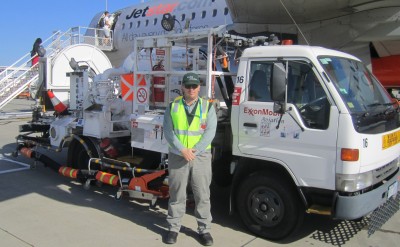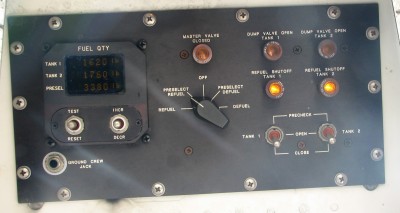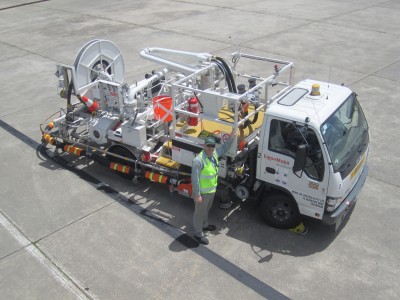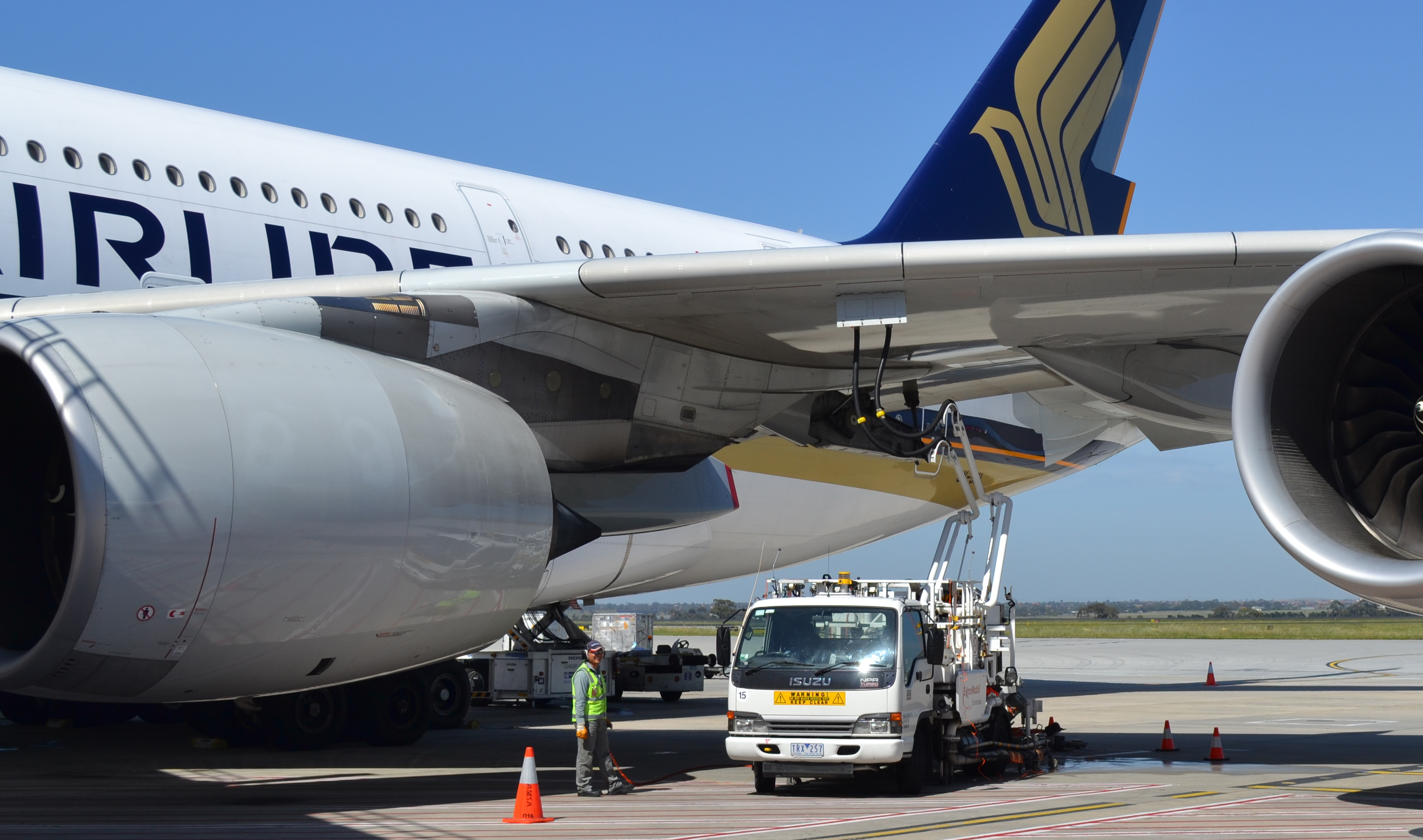Most people never really think about what is involved in getting a plane ready before take-off. One of those important jobs is refuelling the aircraft. It’s something the general public doesn’t get much insight about, so clearly I jumped at the opportunity when offered to shadow the refuelling operation for a few hours at Melbourne Airport (IATA: MEL).
The plane is an A380 from Singapore Airlines and I’m standing right under its left wing between the two Rolls-Royce Trent 900 engines. Above me I can see an open wing panel with two large pipes connected to the wing. Beneath all this the comparatively small refuelling truck and Will, a jokingly happy 36 year old Filipino who came to Australia when he was 10, holding what they call the deadman device firmly in his hand.
Refuelling the Singapore bound Airbus A380 with registration 9V-SKI will take Will about an hour. During this time he can’t leave the site, nor can he sit down or do anything other than holding the safety device permanently in his hand not forgetting to let go of the lever every now and then for a brief moment in order to confirm that he is – well – still alive. It’s not a joke, but rather one of a number of cleverly thought through safety features. If he let go of the ‘deadman’ device, the system would immediately stop the refuelling process.
On this sunny Thursday morning the captain of the Singapore flight requested the Airbus to be filled with about 10% more fuel than on other days. Will tells me that’s likely due to anticipated weather patterns that require more fuel en route to Singapore. Fuel orders are radioed to the company’s operation centre, located just outside the airport perimeter. From there the order is directed to an available refuelling truck driver for execution. Sometimes initial orders are provisional only and the drivers fill the planes up to a certain, safe amount before they get the final numbers. But since it can take a long time to refuel (e.g. a Los Angeles bound A380 can take about 2 hours to fill up), getting started with the job is essential for a timely operation.
Earlier in the day another refuelling truck driver, 29-year-old Adam, who is refuelling domestic planes today tells me that it’s not uncommon to see differences in fuel loads on the same route. If a few planes take similar amounts but one requests less, he would notify the flight engineer so that they can double check the numbers, weather patterns and so on. In a way the refuelling guys add another safety layer to the system.

Adam after he finished refuelling the JetStar plane
With Adam who started at 5am this morning and recently relocated from Darwin where he used to work for the competition, I witness the refuelling of a Qantas Link Dash-8. This aircraft type is tricky for the refuelling guys as its fuel panel displays the fuel amount in pounds but the orders come in kilograms and – to make matters worse – the invoice is issued in litres. So again, double-checking the numbers is important and a little math affinity goes a long way in this job. The system of course has redundancy checks in place and at the end of each refuelling job the flight engineers check the numbers and sign the receipt.

The panel of a Dash-8 Q400 series
A little later I have lunch with the self proclaimed aviation super nerd Bruce, 43, who got introduced to the job through a friend in 2005 back in Sydney. Bruce who has a pilot license himself is in charge of training up the newbies and making sure procedures are followed to the letter. He says this is his dream job because he gets to work around planes all day long. When it’s safe and he has a moment, Bruce will take every opportunity to photograph and write about the planes at the airport. His Flickr collection is impressive.
But Bruce isn’t just running around taking pictures of planes. His experience and extensive knowledge makes him what you would call the libero in soccer for the operation as he is filling in the gaps where and when needed. He tells me his employer has about 40 staff, 17 trucks and runs a 24-hour operation in Melbourne. With that they go through about 4 Million litres of A1 Jet Fuel per day.
Happily chatting away, we suddenly get a radio call with an order to refuel a Qantas Boeing 747-438/ER. The VH-OEH registered plane only ordered a small amount of fuel because it will be flying empty to Sydney as part of a relocation flight. In this business a small amount is relative though, the amount of fuel ordered would still fill about 400 cars.
When we get to the Jumbo Bruce positions the truck right under its wing, secures the area around the truck with traffic cones, connects the anti static device then links the pipes to the ground outlet before connecting it up to the wing. He then checks the fuel panel on the aircraft, enters the total required fuel load and starts the refuelling itself. Most aircraft handle inflow distribution to the various tanks automatically but sometimes manual adjustments are needed in order to make sure the load is evenly distributed.
After the desired amount is filled, Bruce disconnects the pipes from the wings, closes the panel, removes the ground pipe and static device, prints the receipt and gets the engineer to sign it before removing the traffic cones. He then radios the operations centre for getting the details of the next job.

Bruce and his truck before going to his next task
For me it is the end of the day. Before I leave I need to ask Bruce one last burning question: where do the refuelling trucks get refilled? He laughs and points to a small diesel pump on the edge of the car park where the refuelling trucks are parked.
[All pictures except the one of the Dash-8 fuel panel are copyright LateDeparture; Dash-8 Fuel Panel is copyright BruceK68]


Thanks, Tom. One of your best posts ever. (Yup, been checking for a couple of days and happy to see the links finally working as I did not want to miss reading the full text of tis post.) Yup again! I’d like to see more mosts from the tech and operations side of things. Great post!!
Thanks a lot for your compliment. I will take your suggestion for more tech and ops posts onboard!
Thanks. If I forgot to mention it, I LIKE your Blog. Tech and oops is my thing, but all of your posts are spot-on good reading! Thank you!! C.
Thanks, much appreciated! Spread the word I love a growing reader base 😉
thanks for every one who envolving this to improve our knowlage
hello tom, im trying to find out how to become a refueller at melbourne aiport, could u point me in the right direction
Hi Daniel, I sent you an email with more details. Good luck!
Hello Tom
Out of work pom with 10+ years experience refuelling @ LHR looking for a overseas challenge? Can you help/suggestions?
Regards
Chris.
Hello Tom, great post was wondering how one becomes a refueller at Melbourne Airport? As Daniel would be interested in enquiring.
Senior Fuels Engineer/ Driver Aircraft Fueler
( AIR BP) with a highly experienced Aircraft Refueller, over 14 years of
domestic and International experience in performing aircraft refueling for
different type of airplanes civilian and military, looking a any aviation
job. Skills in the following areas: testing, storage and distribution of
petroleum aviation in storage areas, system components, risk and reliability,
fatigue management, safety. Last job Bus Driver- First Group ( National Insurance Number,Visa Debit card ).
Hey! New Zealand aircraft refueller, all licences included, would love any extra information emailed to me about job vacancies etc!! Cheers 🙂
romankerr@hotmail.com